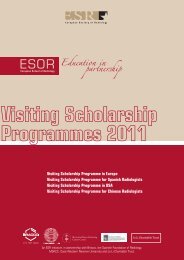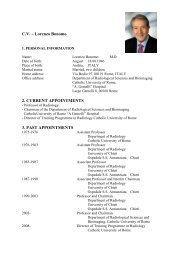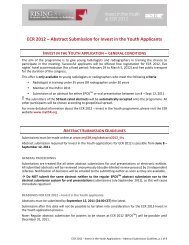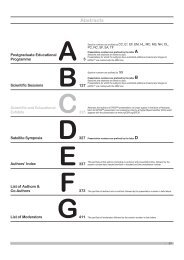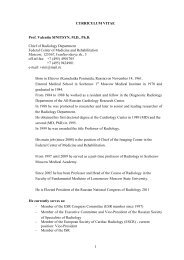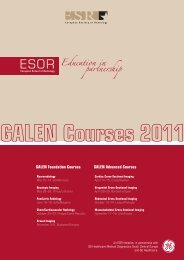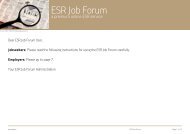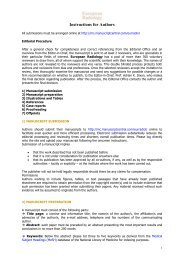<strong>Postgraduate</strong> <strong>Educational</strong> <strong>Programme</strong>of irradiated rectal cancer is 47%-54%. The major cause of overstaging is diffusehypointense tissue infiltration into the mesorectal fat, related to marked fibrosis ofthe bowel wall and desmoplastic reaction. Replacement by fibrotic scar tissue withan island of residual adenocarcinoma can make it difficult to identify viable tumouron MR images, causing understaging. Imaging after CRT is not sufficiently accuratefor identifying complete responders, with PPVs ranging from 17 to 50%. In mostcases, a hypointense scar replaces the site of disease, and the major componentof error on MRI is overstaging due to its limited capability to differentiate betweenviable tumour, residual fibrotic tissue, and desmoplastic reaction. DWI in additionto standard MRI significantly improves the performance of radiologists to selectcomplete responders.Learning Objectives:1. To learn the rationale for following-up on patients after neoadjuvant chemoradiation.2. To understand conventional imaging criteria for assessing tumour response.3. To learn about new techniques for assessing response, including diffusionMRI and PET/CT.A-010 16:55C. Assessment of anal cancer responseV.J. Goh; London/UK (vicky.goh@kcl.ac.uk)Anal cancer is an uncommon cancer, accounting for 1.5% of all gastrointestinalcancers, but is increasing in incidence. Anal cancer is predominantly a loco-regionaldisease; less than 5% of patients have disease outside the pelvis at presentation.Definitive chemoradiation, combining radiotherapy with concomitant 5-fluorouraciland mitomycin C, is recognised to be the optimal treatment modality for squamouscell cancers of the anal canal and margin, offering good loco-regional control andsurvival rates similar to surgery. Traditionally clinical examination and proctoscopyhave been the main tools for locoregional tumour assessment, however, in recentyears, imaging has become the method of choice for assessing tumour regressionfollowing chemoradiation. The advantage and limitations of the different imagingtechniques in assessing response will be described. The complications of treatmentand imaging appearances will also be discussed.Learning Objectives:1. To learn the rationale for restaging after therapy.2. To know how to assess the tumour response with conventional imaging criteria.3. To learn about new techniques for assessing response in anal cancer, includingdiffusion MRI and PET/CT.Panel discussion:What clinicians expect from us in rectal and anal cancer staging andrestaging? How should we image patients? 17:1516:00 - 17:30 Room D2CardiacRC 303Cardiac imaging: the cutting edgeModerator:E. Di Cesare; L’Aquila/ITA-011 16:00A. Cardiac MRI: do we need more than 1.5 T?B.J. Wintersperger; Toronto, ON/CA (Bernd.Wintersperger@uhn.ca)1.5 T cardiac MR imaging is a main stay of cross-sectional imaging of various cardiacdiseases and has proven high accuracies and new insights into diseases. Basedon its success, diagnostic approaches have changed and also risk assessmentfor some cardiac diseases has become possible. Based on continuous technicaldevelopments though higher field strength have become available in recentyears with clinical use of 3 T and research use of 7 T. However, specific changesthat come along with the increase in B0 have to be incorporated in most aspectsof a cardiovascular MR imaging procedures; from patient screening to imagingtechnique details. Basic changes at higher B0 are: B0 proportional increase ofSNR, substantial increase in RF deposition, changes in magnetic tissue propertiesand B0/B1 inhomogeneities. While most of these changes affect all aspectsof cardiac imaging at 3 T, some may only affect certain applications (e.g. assessmentof myocardial iron). CE MRA benefit from SNR increase at higher B0 (e.g.3 T) and improved background suppression based on short TR and prolonged T1values. While some applications at higher B0 have not yet been proven to impactdiagnosis signal starving applications at 1.5 T (e.g. myocardial perfusion), alsosubstantially benefit from the B0 increase. The work horse of cardiac MRI, cineSSFP is affected by off-resonance artifacts at higher B0, with proper adjustments(shimming, frequency scouting) though diagnostic image quality can be maintained.Most importantly, in daily routine also the safety aspect of the patient with potentialdevices has to be taken into account.Learning Objectives:1. To learn about the differences between 1.5 T and 3 T cardiac MRI.2. To understand the clinical applications of high-field cardiac MRI.3. To become familiar with the problems of using high-field cardiac MRI in dailyroutine.Author Disclosure:B. J. Wintersperger: Speaker; Siemens Healthcare, Bayer Healthcare.A-012 16:30B. Cardiac CT: technique in 2020; where to next?K. Nikolaou; Munich/DE (konstantin.nikolaou@med.uni‐muenchen.de)In recent years, technical advances and improvements in cardiac computedtomography (CT) have provoked increasing interest in the potential clinical roleof this technique in the non-invasive work-up of patients with various cardiacdiseases - most importantly in patients with suspected coronary artery disease(CAD). Within the next years, several trends are foreseeable: from a researchstandpoint, the strengthening of clinical evidence by larger, randomised, clinicalmulticentre trials for cardiac-CT indications can be expected. From a technicalstandpoint, there are two main fields of interest and technical developments to beexpected: further optimising radiation dose and image quality, by techniques suchas high-pitch scanning, iterative reconstruction algorithms, wide detectors withsingle heart beat acquisitions and digital detector technology. On the other hand,introduction of new applications and protocols, such as the combined assessmentof cardiac morphology, function, and viability/perfusion, will broaden the clinicalapplicability of cardiac-CT.Learning Objectives:1. To learn about the latest technical developments in state-of-the-art cardiacCT.2. To explore what new developments will influence cardiac CT over the nextfew years.3. To understand if what you need is a lot of rows, tubes or both for optimalcardiac CT.A-013 17:00C. Cardiac hybrid imaging: “One-Stop-Shop”P.A. Kaufmann; Zurich/CH″Abstract Not Submitted″Learning Objectives:1. To understand the principles of cardiac hybrid imaging.2. To learn about the diagnostic value of hybrid imaging.3. To know about possible indications for performing hybrid imaging.16:00 - 17:30 Room E1Molecular ImagingRC 306Molecular imaging in oncologyModerator:O. Clément; Paris/FRA-014 16:00A. New PET-tracers for oncologyP.L. Choyke; Bethesda, MD/US (pchoyke@nih.gov)PET tracers represent an exciting development in the imaging of cancers. Becauseof the sensitivity of PET (nano-pico molar sensitivity vs. micromolar for MRI), it ispossible to image cell membrane-based receptors responsible for the abnormalgrowth associated with cancers and detect subtle changes in the integrity of cancercells. FDG-PET /CT has been the trailblazer agent, demonstrating unique sensitivityfor cancers, however, while FDG uptake does reflect glycolysis, it is relativelynon-specific and, to date, has not dictated the choice of therapies. The promiseof new PET agents is that they will aid clinicians in adding or deleting therapiesdepending on the pharmacodynamics of the imaging biomarker. For instance,classes of agents have been developed to investigate angiogenesis, proliferation,S8AB C D E F G
<strong>Postgraduate</strong> <strong>Educational</strong> <strong>Programme</strong>hypoxia, apoptosis, hormone sensitivity and amino acid transport. Each of theseprovides a unique window on the biology of each cancer and will hopefully guidetherapies in the near future. In the specific example of metastatic prostate cancers,Sodium Fluoride PET is proving far more sensitive than conventional bone scans.Agents such as F-ACBC (amino acid transport), F-DCFBC (Prostate MembraneSpecific Antigen PSMA), F-DHT (androgen receptor) and F-Choline (cell membraneturnover) are proving efficacious in the detection of metastastic disease and reflectactual tumour burden in contrast to existing methods that only indirectly imagetumour (bone uptake). Thus, there is a rich future in new PET tracers for oncologythat is only in its infancy.Learning Objectives:1. To learn about the new specific tracers that can be used in oncologic patients.2. To become familiar with their possible impact on patient management.3. To understand their potential and limitations for practice.Author Disclosure:P. L. Choyke: Other; Research Agreements with GE, Siemens and Philips.A-015 16:30B. Potential of MRI for molecular imaging in oncologyF.A. Gallagher; Cambridge/UK (fag1000@cam.ac.uk)Imaging targets in cancer range from simple size measurements to more specificbiomarkers on functional, cellular, metabolic and molecular levels. As our understandingof basic tumour biology has advanced, techniques have been developedto exploit this information to produce increasingly specific molecular imaging tools.The biodistribution of these molecular imaging probes should be more specific indiagnosing and assessing cancer than the morphological information acquiredusing anatomical imaging alone. This lecture will discuss current and emergingfunctional and molecular imaging techniques using MRI and their applications inoncology. Functional measures of tumour blood flow and vascular permeability canbe made using dynamic contrast-enhanced MRI. Diffusion-weighted imaging is asurrogate for the cellular content of the tumour and emerging methods can be usedto probe features of the extracellular space such as tumour pH and stromal content.On the molecular level, cell surface expression of specific proteins and enzymeactivity within the cell can be imaged; labelled probes have been developed whichbind to these proteins and a new MR technique is being developed for assessingtumour glucose in a similar way to PET. Hyperpolarisation methods are emergingto overcome the major limitation of MR: its low sensitivity. One such approach isdynamic nuclear polarisation, which can probe carbon metabolism non-invasivelyin patients with cancer. Functional and molecular imaging techniques with MRI willincreasingly be used in radiology in conjunction with anatomical imaging methodsto improve diagnosis and prognosis, target biopsies, as well as predict and detectresponse to treatment.Learning Objectives:1. To become familiar with the different approaches to molecular imaging withMRI.2. To understand the role of molecular imaging in oncology.3. To learn about emerging MRI techniques for molecular imaging.Author Disclosure:F. A. Gallagher: Grant Recipient; GE Healthcare.and to monitor cancer therapy. First molecular ultrasound microbubbles are currentlyunder clinical evaluation. Since microbubbles can also be used to permeate thevasculature locally and to transport drugs, its theranostic potential will be outlined.Learning Objectives:1. To become familiar with optical imaging techniques and probes.2. To learn about the potential of targeted US contrast agents.3. To appreciate emerging hybrid imaging techniques.Author Disclosure:F. M. A. Kiessling: Board Member; ESR Research Board, Council ESMI.Founder; invivoContrast GmbH. Grant Recipient; DFG, BMBF, EU. Research/Grant Support; Financial support by Bracco, Bayer, Philips, Roche, AstraZeneca.16:00 - 17:30 Room E2Multidisciplinary Session: Managing Patients with CancerMS 3Colorectal liver metastasesA-017 16:00Chairman’s introductionV. Vilgrain; Clichy/FR (valerie.vilgrain@bjn.aphp.fr)Patients with colorectal liver metastases require a multidisciplinary approach includinghepatobiliary surgeons, oncologists, diagnostic and interventional radiologists.This session will cover the most important issues in these patients. The role ofimaging in assessing intra- and extrahepatic staging will be discussed. Cases willillustrate the most recent improvements in imaging such as diffusion-weighted andliver specific contrast-enhanced MR imaging. Curative hepatic surgery is standardof care for resectable patients, but most patients are not initially resectable. The resectabilitydepends on the size, location, and extent of disease. Resectable and nonresectablecases will be shown as well as two-step procedures such as portal veinembolisation which allow surgical resection in patients who cannot initially meet thesurgical criteria. The role of systemic chemotherapy with or without targeted therapyis crucial in patients with resectable or non-resectable colorectal liver metastases.Notably, chemotherapy can render resectable patients who are unresectable. Yet,these treatments can induce hepatotoxicities. Last, interventional radiology plays animportant role in these patients allowing local ablation or endovascular treatmentssuch as hepatic arterial chemoembolisation and selective internal radiation therapy.Session Objectives:1. To learn about the prognostic factors of colorectal liver metastases.2. To become familiar with the most common therapeutic strategies.3. To understand the role of the multidisciplinary team in patients with colorectalliver metastases.A-018 16:05Role of imaging in the pretreatment assessmentV. Vilgrain; Clichy/FR (valerie.vilgrain@bjn.aphp.fr)ThursdayA-016 17:00C. Emerging molecular imaging techniquesF.M.A. Kiessling; Aachen/DE (fkiessling@ukaachen.de)Optical in vivo imaging derives from microscopy techniques and is establishingas a valuable and cheap tool in preclinical research. Some optical methods haverecently been translated to the patient and show promising results. However, theability to gain quantitative or spatially high resolved data differs between opticalimaging methods. Therefore, principles, strengths and limitations of optical reflectanceimaging, mesoscopic epi-fluorescence tomography (MEFT), and fluorescencemolecular tomography (FMT) will be discussed. Optical imaging benefits from beingcombined with CT or MRI and it will be show how µCT not only improves the localisationof fluorescent spots within animals but also improves the reconstruction offluorescent raw data. Also in PET-CT, CT data is not only used as a morphologicalcorrelate but also to perform the attenuation correction. This is much more difficult,when using PET in combination with MRI. A possible solution is the use of UTE-Dixon MR sequences that can reliably distinguish fat, soft tissue and bone, whichare the tissue components with most different photon absorption. The last part ofthe talk is dedicated to molecular ultrasound imaging. Here stabilised gas bubbleslinked to targeting moieties are used as intravascular contrast materials. Markersof vascular inflammation and of angiogenesis can be addressed. Many preclinicalstudies successfully applied molecular ultrasound imaging to characterise cancerThere are various treatments for liver metastases from primary colorectal cancerincluding surgical resection, non-surgical ablative treatments, and chemotherapy.Yet, surgical resection with perioperative chemotherapy has been shown to be thebest treatment option for cure in these patients. Therefore, the role of imaging in thepretherapeutic assessment is key and can be splitted into four topics: 1) diagnosis ofliver lesions as liver metastases, 2) extrahepatic staging including nodal metastases,peritoneal implants, regional or local recurrent or residual disease, and pulmonarymetastases, 3) intrahepatic staging which aims to define number and extent of livermetastases in the segmental and lobar distribution in order to evaluate surgicalresectability or feasibility of non-surgical ablative treatments, 4) and eventuallyresponse to chemotherapy with or without targeted therapy. Multimodal imaging isneeded to answer all these questions. The most important imaging modalities areCT, MR imaging and PET. Multidetector CT is particularly helpful for whole bodyinvestigation and anatomic information for surgical planning. MR imaging is betterthan CT for lesion detection and lesion characterisation in the liver in particular withdiffusion-weighted images and sequences using liver-specific agents. PET imagingis highly sensitive in detecting extrahepatic metastatic lesions, particularly whenCT and PET interpretation can be combined. Pretherapeutic and intraoperativecontrast-enhanced ultrasound may complete the work-up.Learning Objectives:1. To become familiar with imaging findings indicating surgical resectability.2. To understand the role of CT and MR imaging in staging liver metastases.3. To learn about the role of new imaging techniques in staging liver metastases.AB C D E F GS9



